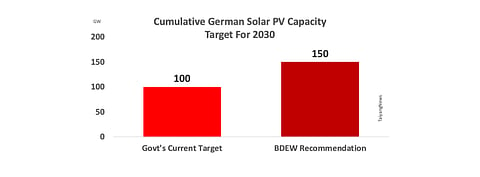

The German Association of Energy & Water Industries (Bundesverband der Energie- und Wasserwirtschaft, BDEW) has called on the government to become ambitious in its approach towards renewables, especially solar PV. In a new PV strategy document released, the utilities union in Europe's largest solar market, has suggested raising solar PV's expansion target to at least 150 GW installed capacity by 2030, meaning 10 GW new capacity addition annually. The association believes it is 'necessary and possible'.
"In addition, there could be quantity shifts from onshore wind energy to photovoltaic, which can increase the expansion target again," the association added.
It would be at least 50 GW more than 100 GW the present government aims to achieve by 2030 (including over 52 GW already installed) with 5 GW annual target. However, the current Conservative/Socialdemocratic government still needs to provide details how they want to reach their more ambitious CO2 reduction targets by 2030 they recently passed. Moreover, the Green Party has gained traction ahead of the country's September 2021 national elections, seen in some polls as the most popular party these days. Currently, Germany's total installed solar PV capacity stands well over 52 GW.
BDEW has further called to have a minimum of 5 GW tender volume for large scale and rooftop solar each. It wants additional segments in the standard tender for innovative PV system concepts as agri-PV or agrivoltaics, building integrated PV (BIPV), floating solar and hybrid PV systems for flexibility, and to not be inhibited by lack of space.
In addition to the recommended 10 GW volume for standard tenders, for innovation tenders, the initial volume should be increased to 250 MW. At the same time, the association expects the government to create a separate remuneration category for BIPV projects with up to 750 kW capacity.
According to the PV strategy of BDEW, incentives for community solar for apartment buildings (Mieterstrom) under EEG 2021 must be made more attractive, with a funding level of between €0.035 per kWh and €0.05 per kWh depending on the system size.
They want the policymakers to make rooftop solar systems more attractive to be installed by households and businesses alike, including for self-consumption. It has also suggested making the tender process more simplified and digitized.
"We need a consistent mix of instruments consisting of financial incentives for companies and citizens, noticeably more flexibility in the choice of how to use the electricity generated and a clear reduction in bureaucracy relating to the construction and use of PV systems," said BDEW's CEO Kerstin Andreae.
BDEW's recommended PV strategy titled Die Energiewende braucht einen PV-Boom or The Energy Transition Needs a PV Boom is available on its website (in German language).
Germany's highest court, earlier in May 2021, called on the government to revise its climate targets to an upward trajectory according to which the country would aim for climate neutrality by 2045, which means it could expand the annual 5 GW PV expansion target.
A recent report by Stiftung Klimaneutralität, Agora Energiewende and Agora Verkehrswende claimed Germany would need 385 GW of installed solar PV capacity by 2045 to meet its climate targets, which means 150 GW by 2030 (see Germany Needs 385 GW Solar PV Capacity To Meet 2045 Goal).
